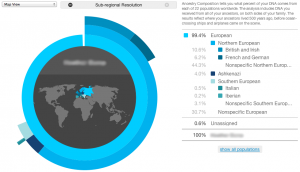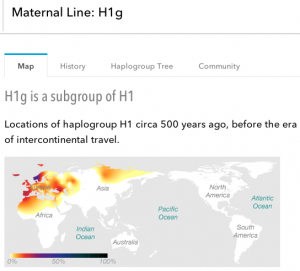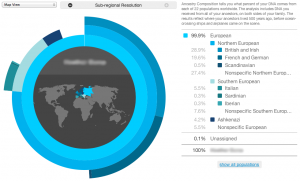Previously, I’d done some analysis on the results of the DNA test I’d completed recently. That can be found here: (Background | Results). My fiancée asked if I could do a write-up about her results too, so I did, and gave it a snarky title.

The standard estimate of her ancestry composition. Name blurred out for privacy reasons.
As expected, she’s very European. While this might seem kind of boring, 23andMe.com‘s sample size of European-descended groups is large enough that their results are way more fine-grained than anything I got and we get to see some pretty interesting things.
First, her haplogroup. Women can only find their maternal haplogroup, because they have no Y-chromosome. To learn her paternal line, we’d have to get her father, uncle, or some male agnatic relative to take this test. Maternally, though, my fiancée belongs to mtDNA haplogroup H1g.

H1g is a subclade of H1 which is a subclade of haplogroup H. Like my mtDNA haplo-super-group M, H is a huge group. The defining mutation of group H arose in Southwest Asia about 20,000-25,000 years ago. The group that became H1 subsequently moved into Europe, where H1 arose about 13,000 years ago in Iberia, and became is the most common mtDNA haplogroup in the continent. However, Europe is so diverse in mtDNA lines that only about 13% of the modern European population belongs to the H1 haplogroup. This means that my fiancée’s haplogroup, H1g, is comparatively rare. We’ve had trouble finding much information on H1g specifically (similar to my problem with M5a and Y-DNA R2 to a lesser extent), but what we can tell is this:
- H1g is more closely related to H1c, H1f, H1k, and H1q than it is to other subclades of H1. H1f, at least, moved north toward the Baltic Sea. H1g may have made a similar movement, perhaps with a westward tack, ending up in Doggerland before that area was flooded by the North Sea.
- The highest frequency of H1 is found among Tuareg Berbers, but the highest frequency of H1g is actually found among Scandinavians, Druze (a group of Arabs with roots in Lebanon), and an unknown indigenous ethnic group from Japan (I think this might be the Ainu, but I don’t know).
- H1 as a clade is associated with the Madgalenian expansion into Europe, the movement of H1g would have been a sub-event of this migration.

Map of the Magdalenian culture. How did this haplogroup end up in Japan?
My fiancée, too, complained that no one famous is in her haplogroup. In her words, “H1gs ain’t got nobody.”
When we looked at her ancestry composition (the first image above), a few things sprang out. Since 23andMe has many more European users than users of other groups, they can break their “European” category down into regions and subregions, which I really wish they could have done for South Asia, too, but oh, well.
According to the standard estimate, my fiancée is 10.6% British and Irish, 6.2% French and German, and 44.3% Non-specific Northern European. By reading about 23andMe’s classification methodology, I was able to figure out that “non-specific” means they are secure on the category, but not so sure which subcategory it would fall in. In other words, with the standard estimate, 44.3% of her DNA is pretty securely Northern European, but whether it’s British and Irish, French and German, Scandinavian, or Finnish is still debatable.
According to the conservative estimate, the only thing they’ll definitively place is 0.8% of her genome as British and Irish. According to the speculative estimate, she’s a whopping 76.4% Northern European, but also 13.8% Southern European.

My fiancée’s conservative estimate

My fiancée’s speculative estimate
So there’s a pretty big variance between estimates, evidence of ancestry from all across Europe. But what the test said did jive with her known family history. She knows a lot more specifics than I do, which is helpful. Most of her ancestors trace to Scotland, which is the British and Irish part, and the Netherlands, which is the French and German part (for 23andMe, French and German is more properly France, BeNeLux, and Germany). Through her mom, she also gets some Greek, which accounts for most of the southern European, though maybe it’s been obscured enough that it only comes out in the speculative estimate. There may also be little bits of Italian or Iberian in there as well. Going with the standard estimate, those percentages are the equivalent of one Italian great-great-great-grandparent, though it may also be due to more progenitors further back in history.
One of the most interesting things to come out of the ancestry composition is the percentage of her DNA that is Ashkenazi. The Ashkenazi are historically a very tight-knit group of Jews who migrated to Central Europe in the early centuries AD. In my fiancée’s case, she traces the Jewish part of her ancestry as far back as one ancestor who moved to the Netherlands from southwest Persia in the 17th century. Presumably this man and his descendants married local Jews, which is where the Ashkenazi part comes from. Unfortunately, placing Ashkenazi as a European group obscures any potential Middle-Eastern origins, so it’s hard to tell from the ancestry composition if that’s true. We have found, though, that she does share chunks of DNA with 23andMe users from Iran and other countries in the Middle East, so that may still be the case.

Jewish population in Europe, 1881: from Wikipedia
What is verifiable is the percentage of Ashkenazi ancestry she has. Unlike the other groups, the Ashkenazi percentage in the DNA shows a remarkably small variance between the conservative estimate (3.6 percent) and the speculative estimate (4.2 percent). It seems pretty clear she has about 4% identifiably Jewish ancestry, and indeed, the most recent Jewish member of her family that we know of was her great-great-grandfather (grandmother’s grandfather) who emigrated to the US before World War II. One great-great-grandfather is worth 6.25% of your genome, which is a little high, but pretty close, if we allow for the fact that some of the Non-specific European DNA may be Ashkenazi and that her great-great-grandfather might have had some non-Jewish ancestry himself.
The Greek part of her ancestry is well-known and well-documented, but doesn’t really come through in the Ancestry Composition chart. However, I think I’ve found it.
23andMe also allows you to view your ancestry by individual chromosomes, color-coded by origin:

This is the speculative estimate, but there at the bottom, you can see I’ve pinpointed a chunk of non-specific Southern European DNA on one of her X-chromosomes. If this X-chromosome is the one from her mother (and I think it is, because the other X-chromosome is purely Northern European), that chunk is probably the Greek part. 23andMe doesn’t have a specific category for Greeks, probably because they don’t have enough Greeks in their sample size. They are identifiably southern European, but nothing more than that.
We would need to see the results from more family members in order to better determine which pieces of her DNA come from where, precisely, but her results both answer some questions and raise some more.

I am also H1g on my mothers side, unfortunately I have not been able to find any information on the group. I also think, I’m nobody!!
Does anyone know for sure where is group came from?
Regards
P.Gregory
My haplogroup is H1g.
I found your analysis most interesting and informational. If indeed H1g is as rare as you have said, there is a possibility that your finance and I share a maternal ancestry. If she is interested in pursuing this, please ask her to contact me at my email.
Thank you –
Cary
I’m a H1g, too! My results are very similar to your girlfriend’s. Thanks for the info.
Hello!
I’m also H1g. Your page comes up fairly high on Google!
I’ve traced my maternal line on paper back to east Wales (on the border with England), to a woman called Mary Pearce, who lived there in the late 1700s (I’ve got as far back as her marriage 1772 in Monmouth). She’s my 5 x great-grandmother.
I’m an H1g as well. My maternal line comes from Germany and pre-war Czechoslovakia. Tell her we’re rare, because we are awesome!
I also have H1g haplogroup. I have traced some of my ancestors and so far all are English. 8 great-grandparents all English. Not even a Scot or Welsh ancestor in the group. The rest of my 23andMe analysis is equally boring. 100% European, with only 0.2% Southern European: 49.2% British and Irish. The furthest East is 4.7% Scandinavian (Norway and/or Denmark) and 15.3% French/German. No fun being H1g!